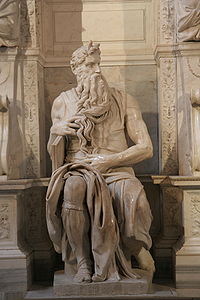
The Moses by Michelangelo can be dated from 1513-1515 and was to be part of the tomb of Pope Julius II. The posture is that of a prophet, posed on a marble chair between two decorated marble columns. His long beard descends to his lap and is set aside by his right hand, which also leans on the plates.
This posture of the seated prophet also appears in Michelangelo’s Sistine Chapel frescoes from a year earlier. In fact, here we have a rare example of Michelangelo as the painter of the Sistine Chapel, influencing Michelangelo as the sculptor.
Moses found his people worshipping the Golden Calf – the false idol they had made. His anger, profoundly sculptured by Michelangelo, defies the prison of stone, the limits of the sculptor’s art.
The world is drawn to the church of San Pietro in Vincoli in Rome to gaze upon the range of human emotions captured in this Moses by Michelangelo, whose own personal turmoil is represented by the tomb he was never allowed to complete.
Michelangelo’s Sculpture of Moses
What we see today is the troubled compromise forced upon Michelangelo when it became clear that the money to finish it, in theory, was to have 40 statues as grand in scale (Michelangelo’s Moses is 8′ 4″ or 254 cm high) and presence as the Moses, was never to materialise. Moses was originally meant for the upper part of the much larger monument, where it would have been seen from below.
This explains the figure’s unusually long torso and overly dramatic expression. Notice the swollen veins in his left arm and his massive shoulders, which seem too large in proportion to the neck.
Why Does Michelangelo’s Moses Have Horns?
Michelangelo’s Moses is depicted with horns on his head. He, like so many artists before him, was laboring under a misconception. This is believed to be because of the mistranslation of the Hebrew Scriptures into Latin by St Jerome. Moses is actually described as having “rays of the skin of his face”, which Jerome in the Vulgate had translated as “horns”. The mistake in translation is possible because the word “keren” in the Hebrew language can mean either “radiated (light)” or “grew horns”.
Michelangelo’s Masterpiece at 38
Michelangelo once wrote, “that a true and pure work of sculpture, by definition, one that is cut, not cast or modeled should retain so much of the original form of the stone block and should so avoid projections and separation of parts that it would roll downhill of its own weight.”
These words reflect Michelangelo’s love of quarried marble and his reverence for the very stone that lies at the heart of his chosen art form of sculpture. In the Moses sculpture, respect and total understanding of his materials and his own abilities combine to create the masterpiece hewn from marble by a 38-year-old at the height of his genius.
It is said that Michelangelo created a new world of art, a colossal planet in which Moses was a high priest. Certainly, in his daring energy, he produced stupendous results, which those who followed him could never imitate without becoming ridiculous or grotesque.
Moses encapsulates Michelangelo’s own courage and passion at a time when he was fighting to be able to complete the tomb of Pope Julius II. The continual battles waged with ‘lesser’ mortals were a constant companion in the life of Michelangelo.
Fighting to create the work he envisaged in the manner and style he felt was given to him by God. It is true he never completed the Pope’s tomb, but in Moses, we can see once again his restless genius at play. He considered it his most important work.